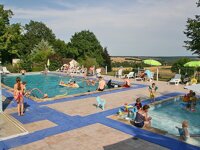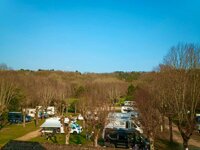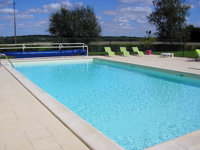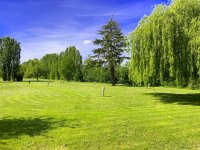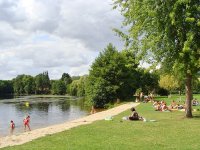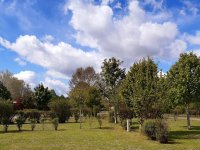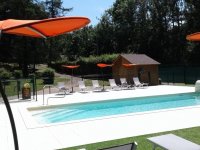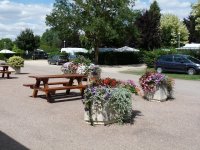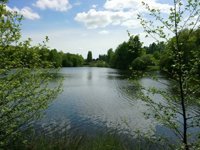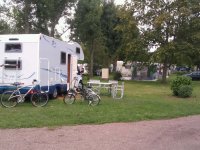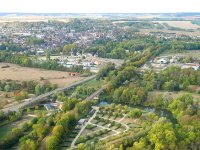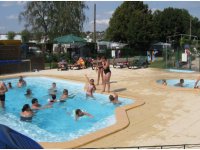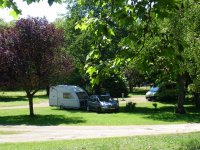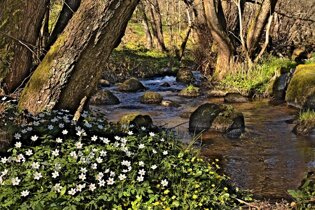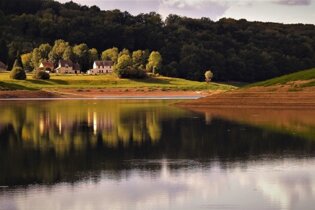Camping in Burgundy
13 campsites in France, Burgundy for Yonne
Campsite Listing Google Map
The following consent is required:
Tracking & performance, Targeting & advertising.
Burgundy
Burgundy is a wonderfully evocative region offering breathtaking châteaux and cathedrals, rolling hills and heady mountain views, vineyards and superlative cuisine, not to mention of course, a wide variety of world-renowned wines.

In the rich heartland of France, Burgundy was once a powerful independent state and important religious centre. Its golden age is reflected in the area’s magnificent art and architecture: the grand palaces and art collections of Dijon, the great pilgrimage church of Vézelay, the Cistercian Abbaye de Fontenay and the evocative abbey remains at Cluny, once the most powerful monastery in Europe.
However, Burgundy is best known for its wine, including some of the world’s finest, notably from the great vineyards of the Côte d’Or and Chablis, and also for its sublime cuisine. You’ll also notice how driving through the country villages is like reading a wine merchant’s list with plenty of opportunities for tasting and choosing your wine. The area is criss-crossed by navigable waterways and includes the Parc Régional du Morvan; good walking country amidst lush, rolling wooded landscape.
A little history
Its name was derived form a tribe of invaders, the Burgunds, from the shores of the Baltic. The Romans introduced the vine to the province, as they did to Bordeaux, thus instigating a centuries-old wine rivalry between the two regions.
Burgundy has always been a corridor for the great movements of population flowing through it from north to south and east to west. It was, and is, a region of transition. Dijon, Avallon and Auxerre belong, in their urban style as well as the minds of their inhabitants, to the Frankish north. In the southerly Mâconnais and Charollais you come across the influences of the south, in the architecture, the way of life, the climate and the flora. The watershed between the rivers that flow into the Atlantic, such as the Loire and Seine, and those that flow into the Mediterranean, such as the Saône and the Rhône, runs straight through Burgundy.
The golden era of Burgundy has always been regarded as between the 11th and 15th centuries. This was a time of magnificent monasteries and learning, bringing with that immense power and wealth. Abbeys at Vézelay and Fontenay are recognised as UNESCO World Heritage Sites and Cluny was once the largest Christian place of worship in the known world.

Geography of Burgundy
Burgundy’s River Saône meanders gracefully through a rolling landscape of green and gold, studded with castles, mosaic roofs and Romanesque churches. Famous for its wines, the region displays neat rows of vines that flourish in the long, warm summers and produce the fruit that becomes such favourites as Chablis, Meursault and Gevrey-Chambertin. Scattered between are picturesque timbered villages like Noyers-sur-Serein where geraniums spill from pots and pretty squares buzz with the activity of shoppers and artists.
Once central to Burgundy’s prosperity, the canals that lace the terrain fell into decline with the construction of the railways. Today, they’re popular with tourists who want to explore the region – a cruise in a barge is the perfect initiation to the Burgundian way of life: slow, relaxed and enjoyable. Back on dry land, the Morvan Forest is the crowning glory of the Bourgogne for nature lovers. Home to over 150 species of birds, a multitude of tree species and mammals such as badgers, deer and boar, it’s a beautiful place to while away the day.
Camping in Burgundy
Burgundy is a great choice for a camping holiday, partly because it is not a big camping destination. That probably needs a little clarification: Burgundy is a fabulous place, make no mistake, it’s just not full of large campsites bursting at the seams with tour operators and crowds piling into the swimming pool complex.
This is mainly due to the lack of a coastline, of course, but Burgundy has plenty on offer for camping holidaymakers. If you like your campsites more restrained, more low key, more tucked away, then it has some gems for you. A high proportion of Burgundy campsites are small to medium in size – a human scale where you will generally get to know the owners, not just the receptionist.
For many, it is a convenient overnight stop while heading south to the south of France coast (or heading north to catch a ferry). But stray away from the A6 autoroute du soleil and wander down the sleepy country lanes and you’ll find restful campsites with decent facilities and friendly welcomes.
Pitches tend to be grassy, great for those camping with tents, and there’s usually woodland around, and plenty of empty fields where you can stroll and the kids can explore. A short drive will take you inevitably to local castles, places of interest, bustling market towns, animal parks and the like, as well as the big-name must-sees like Beaune.
There are great days out in the vast Morvan regional park or along the slow-moving waters of the rivers and canals. Take a boat trip and let the day slip by. Then by night enjoy the fabulous food and wine. Touring caravanners and motorhomers alike value the campsite restaurants you’ll often find on the Burgundy campsites. When the gastronomic heritage is this strong, you’ll rarely be disappointed!
The wines of Burgundy
So great is the importance of Burgundian wine (its history, viticulture, vinification, diversity and terroir) that the whole region’s vineyards are recognised by UNESCO as having World Heritage status. Burgundy is synonymous with truly great wine, notably from the sublime vineyards of the Côte d’Or, between Dijon and Santenay. Here the Côte de Nuits produces, arguably, the best reds and the Côte de Beaune the best whites. Other illustrious names include Mâconnais, Chalonnais, Beaujolais and Chablis of course, as well as the Yonne, Saône et Loire and Nièvre.
Places of interest

Cluny: Cluny Abbey was important in medieval times and its influence radiated out over the Christian West and stamped its mark, theologically, culturally and politically, upon the entire Middle Ages. Such was Cluny’s power that it eventually became the overlord of over 1,450 monasteries, many in Britain. Cluny even became a driving force behind the Crusades and the Reconquista in Spain and Portugal.
Vézelay Abbey: This Benedictine monastery, south of Auxerre, is held up as a fine example of Romanesque architecture and has been a UNESCO World Heritage Site since 1979. It perches on a tiny hilltop topped off by its wonderful basilica while a bucolic scene lies all around with vineyards, sunflowers and grazing cows.
Fontenay Abbey: Dating from 1118, this is one of the oldest Cistercian abbeys in Europe, set in a peaceful, rural location in a wooded valley. Fascinating for its history but also the barrel-ceilinged monks’ dormitory and the ancient forge which was one of Europe’s earliest, complete with a working replica of the 13th-century hydraulic hammer.
Château de Sully: This grand Renaissance castle sits grandly surrounded by an elegant moat that casts a fine reflection of the structure on a still day. With beautiful proportions and lovely grounds to explore, it’s a popular destination. Do try the chardonnay white wines and pinot noir reds, produced on the estate.
Auxerre: A town founded by the Romans, Auxerre is famous for its Chablis, one of the world’s great white wines. It’s also renowned for its cathedral with the extraordinary stained glass windows and the Saint Germain abbey.
Mâcon: A quiet, flourishing town on the west bank of the Seine. The town is traversed by a 14th-century bridge at one point and there are broad quays and ancient wine cellars, reflecting its importance as the commercial hub of the Mâconnais wine region.
Dijon: One of the principal towns of Burgundy, its historic capital and was once one of the leading centres in Europe for philosophy, art and culture. Foodies will note that it is famed also for its mustard and classic aperitif, the Kir or Kir Royale.
Hospices de Beaune: Founded in the mid 15th century as a hospital for the poor, this gorgeous Gothic building is renowned for its delicate turrets, and multi-coloured roof tiles. The Grande Salle is spectacular and the 18th-century pharmacy is intriguing.
Joigny: Medieval town.
Paray-le-Monial: Romanesque basilica; pilgrimage centre.
Sens: Historic buildings; museum with fine Gallo-Roman collections
Vézelay: Fortified medieval hillside.
Cuisine of the region

Notoriously rich and decadent, Burgundian cuisine is usually full of flavour, quality and – inevitably – cholesterol when it comes to creamy sauces and cheese-based dishes. Many dishes call for wine and use fine, local ingredients such as Charolais beef, Bresse poultry, snails, truffles and mushrooms. The river fish is superb and, courtesy of Burgundy’s location, Alpine and Provençal influences are never far away. Here are a few classics you might come across during your travels.
Boeuf Bourguignon: A classic dish of tender beef slowly braised in a red wine sauce.
Garbure: A heavy winter soup of pork, cabbage, beans and sausage – perfect on colder nights.
Jambon persillé: Ham flavoured with parsley and with its own jelly.
Meurette: Eggs (or sometimes fish) cooked with a red wine sauce with small onions.
Gougère: cheese pastry based on Gruyère.
Matelote: freshwater fish soup, usually based on a red wine sauce.
